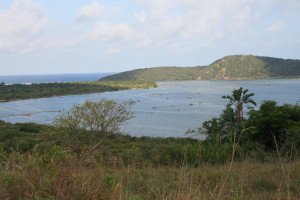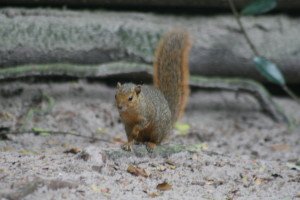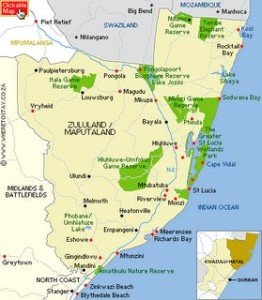
The view over Kosi Bay estuary with the traditional fish traps
The KZN Ezemvelo Wildlife camping site at Kosi Bay is situated in thick coastal forest close to the edge of the kuNhlange lake, the biggest of the four that make up the estuarine wonder at the remote north-eastern border of Natal.
Each camp site is secluded away amongst the mangroves, thereby providing ideal habitat – one of their favourite trees and close to water – for the special gem that is Blackthroated Wattle-Eye.
These busy little birds, that are somewhere between a flycatcher and a batis, are uncommon and easily overlooked, but they’re easier to spot when they pass through the trees in your campsite, as they did at Kosi Bay!
Other birds seen without having to venture far from the comfort of my camping chair were Pygmy Kingfisher (a pair had taken up residence on the road to the ablutions and were seen every day), Natal Robin, which was resident at my site and put on a superb performance of all its many calls, imitating tchagras, cuckoos, nightjars and even African Fish Eagle; Olive Sunbird, Squaretailed Drongo, Terrestrial Bulbul, whose presence I was alerted to by a loud tapping noise as it thumped a caterpillar on a branch; Goldentailed Woodpecker and Blackbellied Starling. I was also surprised to see African Hoopoe in such thick forest.
Kosi Bay is also home to an isolated population of the Red Bush Squirrel and there was an endearing family at my campsite, full of cuteness and a penchant for nibbling at my soap! Samango Monkeys kept to the treetops and were far more pleasant to live next to than their Vervet cousins.

Red Bush Squirrel
One of the main attractions at Kosi Bay is the marvellous snorkelling that can be done at the Sanctuary Reef inside the mouth of the estuary. Unfortunately the tide was going out when I dived, meaning there was a strong current and with snorkellers encouraged not to put their feet down on the bottom due to the presence of Stonefish, it was hard work and not able to be maintained for very long.

Kosi Bay estuary – the mouth
Fortunately there is always birding to be done and there were several Common Tern on the bank of the estuary and the impressive Whimbrel was spotted coming over the sand dune as one approaches Sanctuary Reef. Even a Caspian Tern came flying over the aquarium-like waters.
Emeraldspotted Wood Dove were seen on the way down to the parking area.
Back at camp, a gentle stroll along the Samango Trail produced a pair of elegant Tambourine Dove and a pair of Brown Robin were also seen on a particularly thick, jungle-like portion of the trail, on the actual path. They are obviously not welcome in camp, presumably out-competed by the Natal Robin. Just to ram home the point, a Natal Robin pooed on the picture of a Brown Robin in the bird book I had left open in camp!
The trail also provides lovely elevated viewsites above the lake, with Purplecrested Lourie flying amongst the tall trees and Whitebreasted Cormorant flying, landing, diving and catching fish.
KuNhlange Lake itself boasted plenty of Pied Kingfisher, their lives made easier by the crystal-clear water, Yellow Weavers and African Pied Wagtail. A pair of Trumpeter Hornbill were seen in the morning flying over the 24.6km long lake and then again back across the water in the late afternoon, leading me to wonder if they were the same pair returning to the same perch?
The attractions at Kosi Bay are spread out over a large area, linked by confusing sandy tracks, and 4×4 and a local guide are essential.
The drive out to Black Rock, a promontory jutting out to sea, provided a pair of Whitefronted Plover on the landmark itself, while Gymnogene and Rufousnaped Lark were seen on the way there, along with Fantailed Widowbirds fluttering slowly about, in the grasslands that are around the Kosi Bay area.

Whitefronted Plover on Black Rock

Kosi Bay is at the north-eastern border of KwaZulu-Natal
Sightings List
Pygmy Kingfisher
Natal Robin
Olive Sunbird
Red Bush Squirrel
Blackthroated Wattle-Eye
African Hoopoe
Pied Kingfisher
Trumpeter Hornbill
Yellow Weaver
Squaretailed Drongo
Tambourine Dove
Purplecrested Lourie
Whitebreasted Cormorant
Terrestrial Bulbul
Southern Boubou
Goldentailed Woodpecker
Little Bee-Eater
Blackeyed Bulbul
Emeraldspotted Wood Dove
Common Tern
Fiscal Shrike
House Sparrow
Spectacled Weaver
Pied Crow
African Pied Wagtail
Blackbellied Starling
Samango Monkey
Familiar Chat
Lesser Striped Swallow
Common Myna
Blackheaded Heron
Gymnogene
Hadeda Ibis
Rufousnaped Lark
Whitefronted Plover
Vervet Monkey
European Swallow
Redeyed Dove
Eastern Coastal Skink
Brown Robin
Whimbrel
Caspian Tern
Yellowbilled Kite
Fantailed Widowbird




